What do Blue Tits Like to Eat?
Alongside the Blackbird and the Robin, the Blue Tit must be among our most treasured garden birds. Instantly recognisable due to their multitude of colours – blues, greens, yellows, blacks and whites – they are one of the commonest and chirpiest visitors to our feeders and bird tables.
Of course, Blue Tits are part of a family of birds that can regularly be seen in UK gardens. Other closely related common visitors include the slightly less colourful Coal Tit, and the bigger Great Tit.
You could be forgiven for thinking that there are only three types of Tit in the UK as the Blue Tit, Coal Tit and Great Tit seem to get all of the attention. However, this would be wrong. There are, in fact, seven types of Tit and other varieties include the Crested Tit, the Marsh Tit, the Willow Tit, and the Long-Tailed Tit. There is also the Bearded Tit, but despite its name, the Bearded Tit isn’t a true tit, therefore we’re not covering it in this article.
The Crested Tit is confined to the Highlands of Scotland and the Willow Tit is now quite rare. However, the Marsh Tit and the Long-Tailed Tit are both increasingly being seen at the feeder, so keep a keen eye peeled, and you might just chance upon one of these beautiful little birds in your garden.
As they’re such popular little birds, we are often asked what Blue Tits like to eat, and if there are any differences in diet between Blue Tits, Coal Tits and Great Tits.
Generally, all three tits like to eat the same kinds of foods – seeds, nuts, and insects – but there are subtle differences to their diets. Read on to find out more.
Tits in the Wild
Like Coal Tits and Great Tits, Blue Tits love to eat insects, seeds and nuts. However, they have a particular penchant for the caterpillars of the winter moth and will fly far and wide to find them.
The winter moth is common across northern Europe and their larvae emerge in early spring from egg masses laid near leaf buds. The eggs hatch after the temperature increases to coincide with the growth of young leaves. This also coincides with the onset of nesting for Blue Tits, which seek out the caterpillars to feed to their young.
Blue Tits can fly quite far to find these caterpillars – beyond their territories – as broad-leafed trees carry a better crop of insects than the conifers they often nest in do.
Coal Tits are the only tit to create a larder. They will collect food and store it for later, so they are able to get through harsh weather or times when food is scarce.
Although, like Blue Tits, they eat insects, they are also particularly keen on beech nuts (often called beech mast) and conifer seeds, which are abundant in their natural environment as they often nest in conifer woods.
As a result, Coal Tits are less frequent visitors to garden than Blue Tits, and when they do come, they are more likely to make fleeting raids than stay for long. But they are still regularly seen, particularly in the wintertime when natural food is scarce.
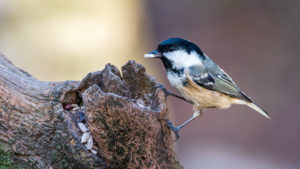
Great Tits are closer to Blue Tits in their diet than Coal Tits and love to forage for insects, caterpillars, spiders, earthworms, flies and moths. When feeding caterpillars to their young, they actually remove the intestines first, rather like your fishmonger gutting a fish!
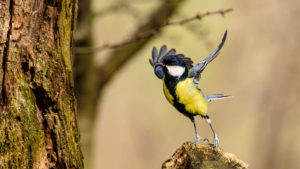
Intelligent birds as they are, they’ve even been known to use pine needles to extract larvae from holes in trees.
In the autumn and winter, when there are less insects about, a Great Tit’s diet changes to favour seeds, nuts and berries. Particular favourites during these times are ivy berries, juniper berries, and mistletoe berries.
Which Wild Bird Food should I feed Blue Tits, Coal Tits and Great Tits?
Because all three Tits have similar diets, they will all thrive on the same individual wild bird foods and blends. This makes life easier as you don’t have to tailor your feeding routine to the individual types of Tit.
Individual Foods
As all members of the Tit family derive a lot of protein from worms and insects, supplementing their diet with Dried Mealworms or Dried Calciworms is a great way to help them remain healthy. Calciworms are the larvae of the black soldier fly and they contain calcium as well as protein, which is essential for egg development and skeletal health.
Although feeding insect protein is particularly important during wintertime, it is also important at other times of the year.
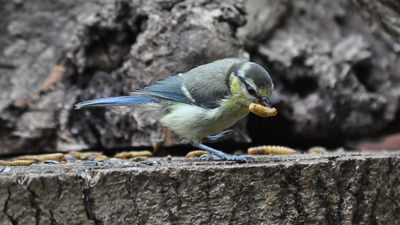
In fact, due to declining numbers of worms and insects generally in the environment, we recommend supplementing with mealworms or calciworms all year round to give Blue Tits, Coal Tits and Great Tits the best chance of survival.
If you decide to supplement their natural diets with other individual food items, then the following will give a super dose of balanced nutrition that will ensure the tits in your garden are happy, healthy and that they return to your feeders to provide hours of captivating enjoyment:
- Black Oil Sunflower Seeds
- Dried Mealworms
- Dried Calciworms
- Niger Seeds
- Suet Products
- Peanuts
- Peanut Granules
- Sunflower Hearts
These, combined with the natural foods in their environment, will give the Tits in your garden the correct balance of protein, carbohydrate and fats.
Wild Bird Food Blends
As with all other species, when feeding Tits, we recommend starting with a good base blend specific to that species. This way, you’ll ensure they’re getting the vast majority of nutrients they need in a single food.
For Blue Tits, Coal Tits and Great Tits, choosing blends with small, energy-dense seeds is essential as this helps prevent predation. Tits, like all small birds, are vulnerable to predators when feeding, so need to take in as many calories as they can in a short space of time. This means they can feed and move off quickly.
To enable them to do this, we recommend our Premium Wild Bird Food from our standard range of blends, or our High Energy No Mess mix or No Mess, No Grow Wild Bird Food.
Premium Wild Bird Food is perfect for year-round feeding. It is husk-free, wheat free and contains Suet Pellets for extra calories. It also contains a variety of small seeds including naked oats, peanut granules and canary seeds, making it a very high energy, high calorie food that Tits can eat quickly.
For a blend that is slightly more tailored to Tits, our High Energy No Mess is also perfect for year-round feeding.
It is totally wheat free and husk free with a high proportion of sunflower hearts, making it a high energy, highly palatable food.
High Energy No Mess contains around 20 different types of wild seeds, and insect suet pellets for the insectivorous protein so needed by the Tit family. It also contains Suet Pellets With Berries, which give an immune-boosting dose of Vitamin C and antioxidants.
If you’re a serious gardener and want to protect your manicured lawn, then we recommend our No Mess, No Grow Wild Bird Food, which has all the benefits of High Energy No Mess, but the seeds have been specially treated to ensure they don’t germinate if dropped.
Finally, some of our other specialist blends will be enjoyed by the Tit family if you are feeding to attract multiple species, including our Robin & Songbird or our Goldfinch Mix.
However, if you really want to attract Blue Tits, Great Tits and Coal Tits to your garden, Premium Wild Bird Food, High Energy No Mess or No Mess No Grow are the blends we really recommend.
For more information on Blue Tits, Great Tits and Coal Tits, visit our Spotters’ Guide.
Our Recent Posts Giving Advice and Guidance on Wild Birds
Ground Nesting Birds
Ground Nesting Birds In an earlier article, we looked at nesting behaviour in wild birds and how you could use this knowledge to encourage birds to nest in your garden. In that article we talked about birds that nest in [...]
Incredible Journeys – Bird Migration Explained
Reading Time: 11 minutes While many species of bird make the UK their home all year round, some just visit for the summer or winter months and then head off to distance shores for the rest of the year. In this blog, we examine bird migration, taking a deep look into one of nature’s most spectacular phenomena to find out more about what makes it possible.
A Guide to Greenfinches
Reading Time: 9 minutes Greenfinches might not have the range of colours of their Goldfinch cousins, but they are still have a spectacular plummage. They are also viewed as one of the best starter birds you can buy by many aviary keepers because they tend to be fairly hardy, have a good song, and don’t have any specific needs that require the management of an experienced keeper.








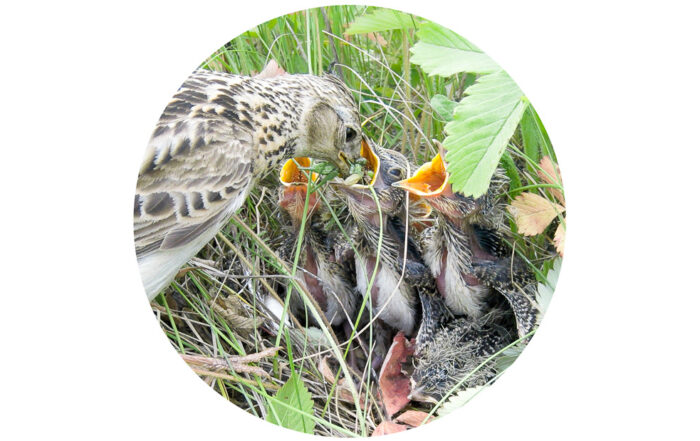
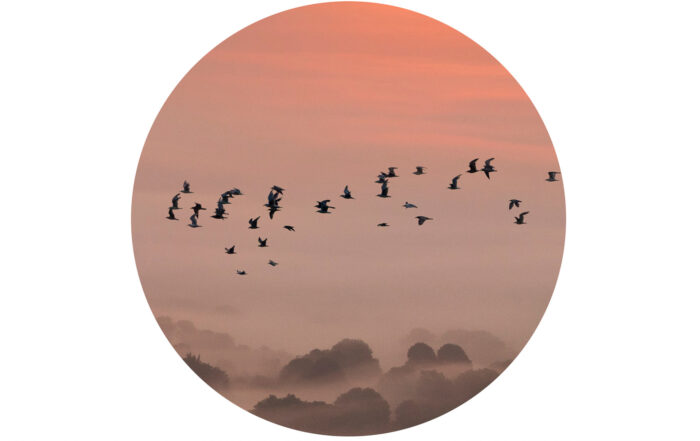
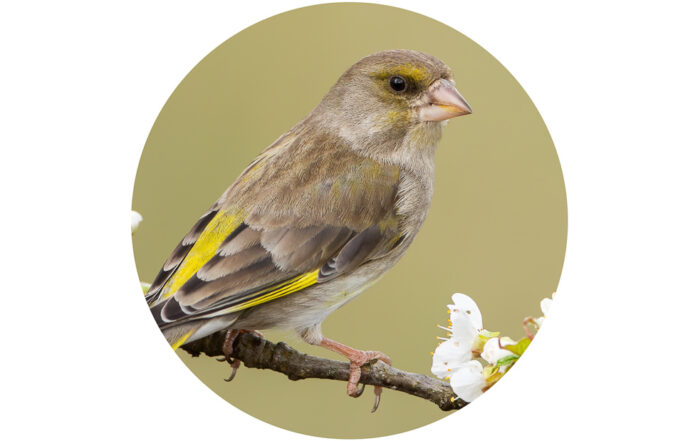
Leave A Comment